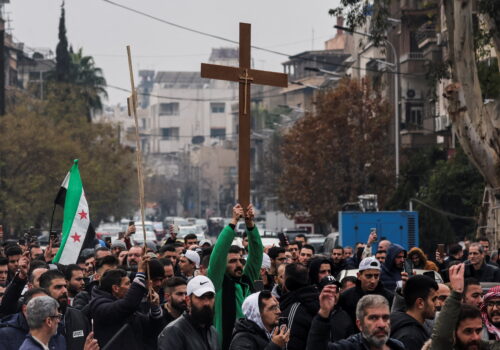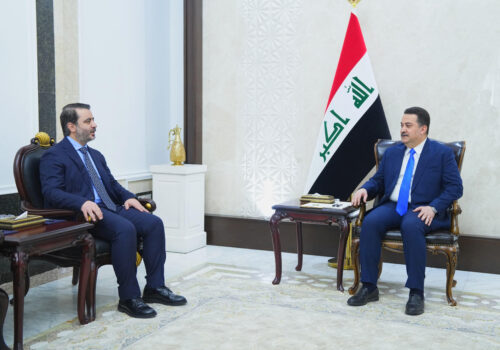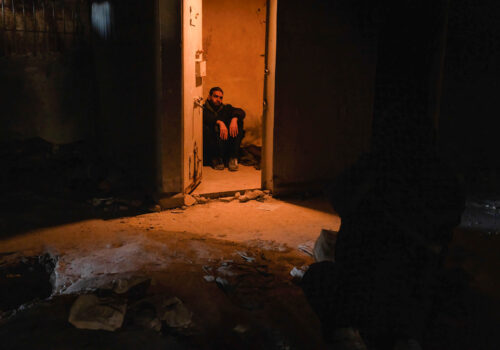Dispatch from Bekaa: Inside the sectarian skirmishes on the Syria-Lebanon border
Qasr, northern Bekaa Valley, Lebanon—Glimpses of everyday life contrasted with scenes of debris and battle damage in this ramshackle village in the northern Bekaa Valley. Local residents hurried up and down the street, purchasing food to break their daily Ramadan fast with the evening iftar meal. On one side of the street, watching the passersby were two members of the powerful Jaafar clan, dressed in black fatigues and standing beside a pickup truck containing automatic rifles, ammunition webbing, and a PKC light machine gun.
“In an hour, you won’t see anyone on the street,” said one of the young men. “They’ll be staying in their homes when the fighting resumes.”
Smashed glass lay scattered over the sidewalk and streets of this town on the border with Syria. Nearby, the wall of a building was pockmarked by shrapnel from an exploding 107mm Katyusha rocket, while further up the street a house continued to smolder after a direct hit the previous day.
Qasr has been the scene of bloody clashes in recent days. Local Shia tribesmen have battled an assortment of Sunni jihadist militias and the new Syrian security forces dominated by Hayat Tahrir al-Sham (HTS), the one-time al-Qaeda-linked group previously led by Syria’s transitional President Ahmed al-Sharaa.
Tensions have been running high along this remote and highly porous stretch of the border since the fall of the regime of Syrian President Bashar al-Assad in December. The area has long been a conduit for smugglers—diesel fuel, solar panels, and the amphetamine narcotic Captagon, from Lebanon to Syria, and weapons and people from Syria to Lebanon.
Those operations have significantly increased since Assad’s downfall and the resulting loss of security control on the Syrian side of the border, sources with the Lebanese Armed Forces (LAF) told me.
In January, HTS-led security forces – what Syria’s new rulers euphemistically name the “Syrian army” – mounted an operation in the area, in what Damascus described as an anti-smuggling campaign.
But the smuggling gangs have grown more assertive, using armed force to defend themselves and averting LAF interception by bulldozing new trails across the more rugged and remote parts of the border. The Syrian security forces have demonstrated a very limited interest in assisting in smuggling crackdowns on their side of the border, only focusing on the area facing Qasr, where smuggling by Lebanese Shias occurs.
Other Sunni-populated areas along the border where smuggling also proliferates have been left untouched by the Syrian security forces. On the other side of the border, opposite Qasr, several villages have been populated for hundreds of years by Shias who have Lebanese citizenship. The operations have made evident that Damascus’s claimed anti-smuggling drive not only sought to prevent Shias from benefiting from the illegal practice but also to drive Lebanese Shias out of their homes and back across the border.
SIGN UP FOR THIS WEEK IN THE MIDEAST NEWSLETTER
“We saw that [HTS] were mobilizing and knew they were coming for us,” said Ali Jaafar, who lived in Akkum, a small village lying one mile north of the border with Lebanon.
The Jaafars are a heavily armed tribe and can muster some 25,000 gunmen. Ali Jaafar said he and his fellow tribal fighters, joined by the Zeaiter, Dandash, and Nasreddine clans, staged several ambushes against the Syrian forces, killing over 40 of them. He claimed —citing both testimonies from detained fighters and identification documents found on the bodies of killed fighters—that most of the fighters on the other side were non-Arabs, including Chechens, Pakistanis, Uzbeks, and Afghans.
However, the Lebanese tribal fighters could not hold out for long. In late February, Ali Jaafar and other residents of Akkum and neighboring villages were forced to flee with their families across the border into Lebanon. The Syrian security forces entered the villages, allegedly looted and burned homes and desecrated mosques and Husseiniyahs, Shia meeting halls.
Hezbollah, which has a strong presence in northern Bekaa, stayed out of the fighting.
“Hezbollah advised us to leave our homes immediately because we would not be able to defend them and they said they would not come to our assistance,” Ali Jaafar said. “They told us they would only intervene if the Syrians entered Lebanon.”
The latest round of fighting began on March 16 when a group of HTS militants sneaked into Lebanon to steal some sheep. The shepherd, who was armed, killed two of the would-be sheep rustlers with rifle fire and wounded a third.
The Syrian government released a statement claiming that Hezbollah had entered Syria, kidnapped “Syrian soldiers” and brought them back into Lebanon before executing them. Hezbollah denied any involvement in the incident. On the ground, Syrian militants—presumed to be HTS-led security forces initially—opened fire indiscriminately against Qasr, launching 107mm rockets and employing 23mm anti-aircraft guns in a flat trajectory, killing a 15-year-old Lebanese civilian. The LAF returned fire with 155mm artillery guns toward the Syrian sources of fire. The LAF also deployed a Cessna aircraft to attack targets in Syria with Hellfire missiles, several sources close to the LAF told me. A LAF position under construction just east of Qasr was hit by a rocket, causing some damage but no casualties.
A Western diplomat in Beirut wryly noted to me that, within 24 hours, a criminal incident of attempted sheep rustling had escalated into a situation in which the army of one state was firing at the military of another state.
The fighting even saw the use of AT-14 Spriggan anti-tank missiles, popularly known in Lebanon by its Russian name, Kornet. One video purportedly showed a Kornet missile striking a building on the Syrian side of the border as a reporter was speaking into his phone. The use of Kornet missiles led many to conclude that Hezbollah must have been participating in the fighting. However, the Jaafar clan has had an unknown number of Kornet missile launchers in its substantial arsenal for several years. Many Jaafars once fought alongside Syrian Alawites in a pro-Assad militia called the Homs Defense Shield, which was supported by Russia. Although the militia was dissolved before Assad’s ouster, the Jaafars were able to retain some of the Kornet missiles.
“The Russians taught me how to fire the Kornet,” Ali Jaafar said, adding that he had recently attempted, without success, to purchase more Kornet missiles on the Syrian black market.
Nevertheless, some Hezbollah fighters took part in the clashes but under the flags of their respective tribes, not under the yellow party banner. The Bekaa Valley is known as the “Barracks of Hezbollah” and is the source of much of the party’s recruitment.
On the evening of March 17, Syrian security forces, backed by Syrian jihadist militias who had arrived from other areas, overran the border village of Hawsh Sayyed Ali, forcing residents to flee. Hawsh Sayyed Ali lies inside Syria, but its population has been predominantly Lebanese for decades. The joint border between Lebanon and Syria has never been appropriately delineated and demarcated, and consequently, there are several areas where Lebanese and Syrian maps have wholly different interpretations of the boundary’s path.
Contacts between Lebanese Defense Minister Michel Menassa and his Syrian counterpart helped ease the tensions, leading to the withdrawal of Syrian militants, but not before they torched several homes before departing. The LAF deployed into the village, uncovered an arms depot during a sweep of the area, and confiscated the contents. The depot probably belonged to Hezbollah rather than the tribes. Hawsh Sayyed Ali was an important clandestine cross-border Main Supply Route for Hezbollah. The LAF’s removal of the weapons led to a video sweeping the internet showing a handful of Hezbollah supporters jeering a passing column of LAF troops in Hawsh Sayyed Ali, calling them “traitors” and yelling slogans of loyalty to former party chief Hassan Nasrallah, who was killed in an Israeli airstrike in September 2024. Hezbollah likely staged the videoed display of anger toward the LAF, as anti-LAF sentiment is not generally felt by the tribes that live in the area. The incident underlines the complex environment in which the LAF operates in the northern Bekaa.
The latest clashes demonstrate the deep ideological hostility felt by Syria’s new rulers toward Shias, Hezbollah in particular, because of its history of military intervention in defense of the Assad regime. Shia and Christian communities in the northern Bekaa express deep concern that HTS and/or other Sunni jihadist groups will stage incursions into Lebanon, either hit-and-run raids to exact revenge or attempts to drive residents from their homes in proximity to the border. While those fears may persist among Lebanese residents, it is unlikely that Damascus will conduct a policy of violent harassment along Syria’s border with Lebanon. However, continued provocations by rogue Syria-based actors remain a threat, particularly if the security situation destabilizes further in Syria, underlining the importance of the Lebanese and Syrian governments engaging in close coordination and cooperation to maintain calm along their joint border.
Nicholas Blanford is a nonresident senior fellow with the Atlantic Council’s Middle East Programs. Blanford covers the politics and security affairs of Lebanon and Syria. He is an acknowledged expert on Lebanese Hezbollah, particularly the organization’s evolving military activities, which have remained a focus of his work for two decades. Blanford is a Beirut-based consultant and a defense and security correspondent for IHS/Jane’s.
Further reading
Wed, Mar 19, 2025
Inside Hayat Tahrir al-Sham’s diplomatic offensive with Syria’s Christians and Ismailis
MENASource By
HTS’s diplomatic offensive demonstrates the leadership’s political approach, which evolved over years of engaging with the Christian and Druze communities in Idlib.
Wed, Mar 19, 2025
Why the United States must bridge the Iraq-Syria divide
MENASource By Sarkawt Shamsulddin
With leverage over both capitals, the United States emerges as the linchpin in delicate diplomatic moment between Baghdad and Damascus.
Thu, Feb 13, 2025
Dispatch from Syria: ‘Syrians cannot focus on their future if they are still drowning in their past’
MENASource By Arwa Damon
The pain felt by those searching for clues in the dark void of the former regime’s detention system is palpable, Arwa Damon reports from Syria.
Image: FILE PHOTO: Civil defence members of the Islamic Health Authority work at a damaged site, in the aftermath of an Israeli strike in Mashghara, in the western part of Lebanon's Bekaa Valley, Lebanon November 10, 2024. REUTERS/Maher Abou Taleb/File Photo



